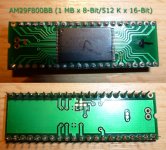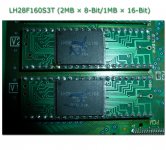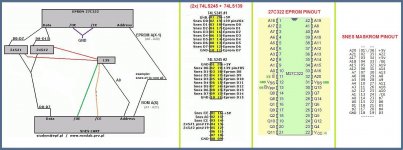mikey
Marked Wolf


- Joined
- Jun 19, 2012
- Posts
- 215
Hey everyone. Just wondering if anybody can lend me a hand with verifying this, letting me know if I'm doing it all completely wrong, giving pointers etc. Basically, I'm trying to develop an adaptor for the 29F032 to conform to the standard DIP42 package like a 27C322 would use. The point is to be able to easily repair 32MBit V roms on Neo carts. That said, I've never used Eagle before, so this is my first crack at things. I had to create the DIP42 and TSOP40 packages, so hopefully I did everything correctly. I'm assuming there are likely errors that I need to fix, but need another pair of eyes at this point. Based upon my reading, I wired it up as follows:
29F032 A0 = Q15 DIP42
29F032 A1 = A0 DIP42
29F032 A2 = A1 DIP42
29F032 A3 = A2 DIP42
etc...
D0-D7 connected between the two, and the rest of the data lines on the DIP42 end left unconnected
29F032 RESET and WE lines tied to VCC, and RY/BY left unconnected (only used when writing?)
Here is a picture of the board layout so far, I'll likely clean it up a little more as I go:

If this is possible and I can get it working, I'll just upload it all to OSH Park for everyone to use. It's all based on the assumption that the 29F032 can be used in this application, but I don't see why it can't seeing as its a 32MBit 8-bit rom.
That's all for now. I'm working on this when I have spare time, so my apologies if it takes me a bit to respond to suggestions.
Thanks guys.
29F032 A0 = Q15 DIP42
29F032 A1 = A0 DIP42
29F032 A2 = A1 DIP42
29F032 A3 = A2 DIP42
etc...
D0-D7 connected between the two, and the rest of the data lines on the DIP42 end left unconnected
29F032 RESET and WE lines tied to VCC, and RY/BY left unconnected (only used when writing?)
Here is a picture of the board layout so far, I'll likely clean it up a little more as I go:

If this is possible and I can get it working, I'll just upload it all to OSH Park for everyone to use. It's all based on the assumption that the 29F032 can be used in this application, but I don't see why it can't seeing as its a 32MBit 8-bit rom.
That's all for now. I'm working on this when I have spare time, so my apologies if it takes me a bit to respond to suggestions.
Thanks guys.






